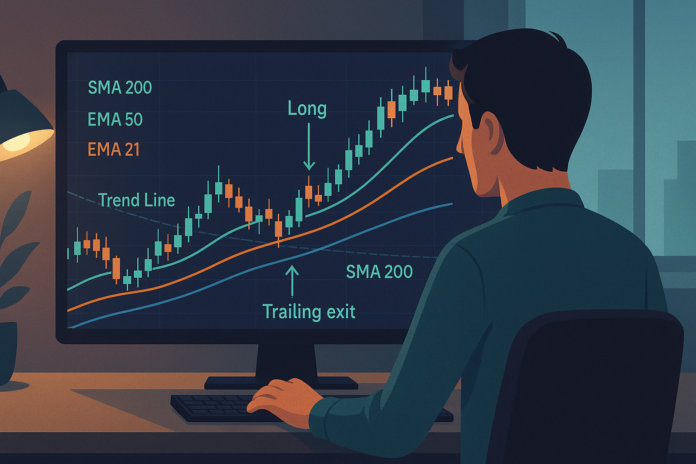
A forex trend trading strategy stands out because it simplifies decisions, you follow direction and ride momentum. It’s about sticking to clear rules and avoiding noise.
When markets trend, trades tend to work. That obviousness helps traders focus on execution rather than speculation.
Understanding the Core Concept
Trend trading in forex rests on one idea: price moves in sustained directionality. Trades are opened with that momentum, and closed when momentum fades or reverses.
In plain terms:
- Identify the dominant directional move.
- Enter in alignment with that movement.
- Hold until signs of fatigue appear.
This clarity creates a structured process, not guesswork.
Using Moving Averages Effectively
One of the most common tools used in trend trading is moving averages. They act as filters, entry triggers, and dynamic support/resistance levels.
Here’s a simple setup:
| Moving Average Type | Period | Role |
| Simple MA (SMA) | 50 | Trend direction |
| Exponential MA (EMA) | 21 | Entry trigger |
| SMA 200 | 200 | Long-term trend filter |
Common tactic: trade only when price is above SMA 200 (bullish), then enter on a pullback to EMA 21 or cross above it. This method shows how to use moving averages in forex for signal clarity.
“Moving averages smooth market noise so you can see the real direction.”
Choosing Suitable Currency Pairs
Not all pairs suit this strategy equally. Ideal currencies offer smooth trending and respectable liquidity.
Best choices often include:
- Major pairs like EUR/USD, GBP/USD, USD/JPY
- Some cross pairs during major sessions
Avoid thinly traded exotic pairs, they often give false signals and whipsaws.
Tools That Support Trend Trading
Execution matters as much as strategy. Reliable charting tools, alert setups, and back-testing capabilities streamline trend trading.
Essential toolset:
- Chart platform (TradingView, MT4/5)
- MA and other trend indicators
- Alerts for price crossing key levels
- Playback or back-testing for validation
Seeing past performance helps refine entry timing and stop placement.
Showing a Real Trade Example
Here’s a trader’s day in action:
- EUR/USD daily closes above SMA 200.
- Price dips to EMA 21 the next day and bounce emerges.
- A long position is entered on the candle close above EMA.
Stop placed just below the swing low. - Trade runs until price closes below EMA 21.
- Result: +50 pips gain on a disciplined move.
Clear plan, consistent execution. That’s trend trading.
Pros and Cons of Forex Trading
Trend trading can be powerful, but forex has features both supporting and challenging traders.
Pros:
- High liquidity in major pairs
- 24/5 market access
- Leverage amplifies gains
Cons:
- Leverage can amplify losses
- Market noise in flat periods
- Overnight swaps and potential slippage
Understanding these helps balance expectations and improve consistency.
Managing Risk Alongside Trend
Risk control is essential to trend trading. Discipline is your ally.
Key methods:
- Limit risk per trade to 1–2% of account
- Use stop-loss orders at recent swing lows/highs
- Scale out partial gains or trail stops as price moves
- Avoid overleveraging, small position sizes preserve equity
“A winning trade is good. But managing risk well ensures you’re still in the game tomorrow.”
Combining Analysis Techniques
Moving averages are helpful but pairing them with price action confirmation enhances accuracy.
Timing refinements can include:
- Checking support/resistance levels
- Candlestick patterns (like pin bars, engulfing candles)
- Trendline breaks
Combining signals often results in better entry points with fewer false starts.
Avoiding Common Mistakes
Some frequent errors in trend trading:
- Jumping in too early before MA confirmation
- Using tight stops and getting knocked out by noise
- Holding trades in a sideways market
- Chasing trades without defined setup
Avoiding these mistakes sharpens performance over time.
Adapting Strategy for Timeframes
The same trend setup works on multiple timeframes but with adjustments:
- Intraday: use 15-min or 1‑hour charts for trend, shorter EMAs
- Daily: focus on daily charts with longer MAs
Test both styles in demo mode to see which fits your rhythm and strategy.
When to Sit Out the Market
Trend strategies work poorly during consolidation. In flat markets, moving averages bunch together and price chases fail.
Signs to pause:
- MA lines flatten and cross repeatedly
- Price trades within a narrow range for days
- News creates whipsaw volatility without sustained direction
Knowing when not to trade preserves capital and clarity.
Journaling and Strategy Refinement
Documenting every trade (even the losers) refines your process.
Essential log info:
- Entry and exit points
- Indicator behavior and time frame
- Reasoning for trade
- Outcome and lessons learned
Reviewing patterns helps you eliminate bad habits and reinforce good ones.
Using Risk Control Tools
Tools can ease discipline enforcement:
- Automated trailing stops
- Trade risk calculators
- Alert reminders for potential stops or exits
These let systems do the heavy lifting while you focus on market observation and strategy adjustments.
Staying Consistent in Execution
Even the best edge disappears without routine. Successful trend traders often share habits:
- Check charts at the same time each day
- Use pre-defined risk settings before trade entry
- Avoid emotional trading during unexpected events
Consistency builds confidence more than occasional luck ever could.
If you have been improving your setup, it’s important to have a clear process. Now is a good time to review your workflow and tools. Do this before you continue making changes.
FAQs
Can I apply trend trading on all currency pairs?
Focus on majors and some crosses,less liquid pairs often give more false signals.
Are moving averages the only indicators I need?
They’re a good foundation, but adding price action and support/resistance levels boosts accuracy.
How much time is needed daily?
Depending on timeframe: intraday traders spend more screen time; daily systems require 15–20 minutes per day.
What’s the best way to exit a trade?
Many traders use closing below EMA or trailing stop above recent swing. Partial profit-taking can also protect gains.
Is trend trading suitable for beginners?
Yes, if combined with disciplined risk rules. The simplicity of rules helps newer traders build structure.
How do I account for market news or time-based volatility?
Avoid trading around major economic releases or switch to small size and wider stops when volatility spikes.





